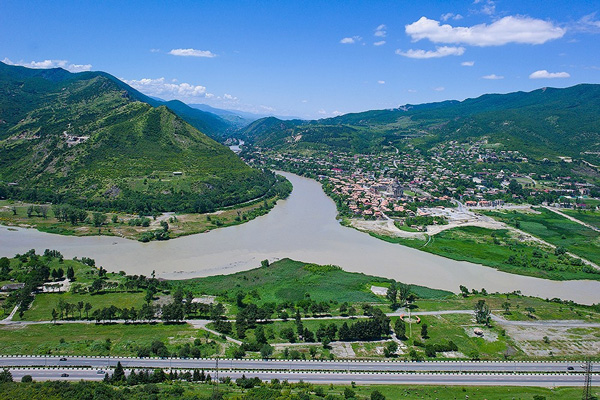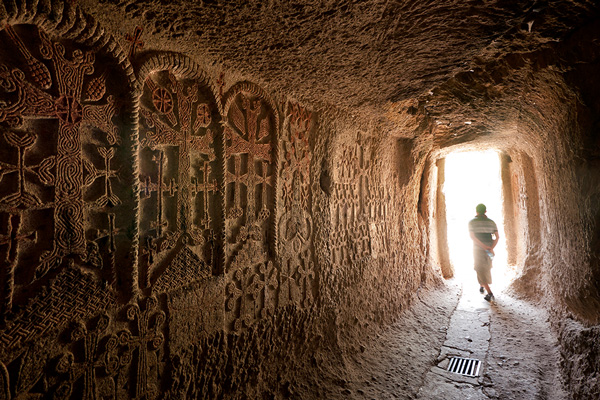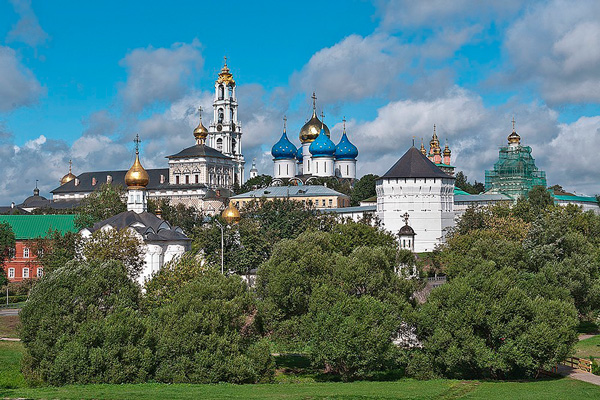As endorsed by the World Heritage Committee at its 42nd session (Manama, 2018), States Parties are invited to actively contribute to the implementation of the UNESCO Initiative on Heritage of Religious Interest by identifying case studies on governance, management and use of properties with associative sacred or spiritual values, including sites with living religious practice, which illustrate interlinkages between the Outstanding Universal Value (OUV) and associative sacred values, cross-thematic interaction between the World Heritage Programmes and Initiatives, as well as synergies between Conventions. Sharing these practices helps other properties and sites find solutions that work. This case study approach provides incentives for States Parties and site managers to reflect on their management practices and explore possibilities for improvement.
On the basis of previous recommendations by the Committee, a series of cross-thematic case studies was launched by the World Heritage Centre, such as consultations on Living Religious and Sacred World Heritage in a Historic Urban Context (in conjunction with the World Heritage Cities Programme), on the Cultural and Spiritual Significance of Wetlands (in collaboration with the RAMSAR Convention), as well as on Astronomical Heritage and Sacred Places (in collaboration with the Starlight Initiative initiated by Spain).
On the basis of identified case studies, in line with the Committee decisions and upon the requests of States Parties, the World Heritage Centre/Advisory Bodies Steering Group on Heritage of Religious Interest developed and implemented pilot projects on Conservation and Management of World Heritage properties of Religious Interest.
World Heritage properties
of Religious Interest
in Georgia

© Ko Hon Chiu Vincent
Case study
on the Historical Monuments of Mtskheta
Since 2008, several meetings took place between His Holiness and Beatitude Ilia II, Catholicos and Patriarch of All Georgia and the representative of the World Heritage Centre within the framework of the Reactive Monitoring missions to the property.
At its 34th session (Brasília, 2010, Decision 34 COM 7A.27), the World Heritage Committee invited the State Party to develop a State Programme for the protection of World Heritage religious properties in Georgia, as a legal framework for co-management under which the respective responsibilities of the State Party and the Georgian Patriarchate are effectively established, monitored and evaluated in relation to the protection and conservation of the property.
A first pilot project, implemented in Georgia (2015-2017) within the framework of the UNESCO Initiative on Heritage of Religious Interest, could be considered a model of Advisory Assistance by UNESCO on protection and management of World Heritage properties of religious interest. Its results and recommendations, endorsed by the World Heritage Committee at its 42nd session (Decision 42 COM 7B.24, Manama, 2018), were closely followed by the Georgian authorities.
In 2019, thanks to the personal support of His Holiness and Beatitude Ilia II, Catholicos and Patriarch of All Georgia, the Patriarchate of Georgia and the National Agency for Cultural Heritage Preservation of Georgia, organized an International Expert Meeting “Conservation and sustainable use of the World Heritage property Historical Monuments of Mtskheta and its setting / Living Religious and Sacred World Heritage in a Historic Urban Context" to discuss the linkages between the World Heritage Convention and the heritage of religious interest, the definition of associated spiritual values, the assessment of all religious activities and practices within the City of Mtskheta, research in the field of religious tourism and pilgrimage, and the role of the religious community in the management of the World Heritage property.
World Heritage properties
of Religious Interest
in Armenia

Monastery of Geghard and the Upper Azat Valley (Armenia) © OUR PLACE The World Heritage Collection
Pilot-Project on
conservation and management
In 2016, a World Heritage Centre Advisory mission visited all Armenian World Heritage properties Monasteries of Haghpat and Sanahin, Cathedral and Churches of Echmiatsin and the Archaeological Site of Zvartnots, Monastery of Geghard and the Upper Azat Valley. It developed a set of recommendations to the State Party to ensure the reinforcement of management mechanisms and capacities required to implement a coherent strategy for their conservation and use.
In 2018, thanks to the full support of the Armenian Apostolic Church, the Ministry of Culture of the Republic of Armenia, in cooperation with the UNESCO World Heritage Centre and the Armenian National Commission for UNESCO, organized a Regional Thematic Expert Consultation meeting on sustainable management of the World Heritage properties of religious interest focused on Eastern Europe.
Thanks to the financial support of the World Heritage Fund and the German World Heritage Foundation, a pilot-project on conservation and management of World Heritage properties of Religious Interest is being implemented in Armenia within the framework of the UNESCO Initiative on Heritage of Religious Interest.
An International expert meeting (on-site or virtual) on Governance for World Heritage of religious interest, including properties under Enhanced protection, will be organized with the participation of international experts, members of the WHC/Advisory Bodies Steering Group on Heritage of Religious Interest, and experts specialized in Enhanced protection, as well as all stakeholders concerned, including the representatives of the Armenian Apostolic Church.
One of three Armenian World Heritage properties of religious interest “Monastery of Geghard and the Upper Azat Valley” is under Enhanced protection. A management plan of this property will be developed within the framework of this pilot project as a first case study introducing the provision for management of enhanced protection, as well as preparatory and emergency measures planned in time of peace for the safeguarding of cultural property.
This pilot project is one of the first activities aiming to establish an operational synergy between two UNESCO Conventions: the 1954 Hague Convention and its two (1954 and 1999) Protocols and the 1972 World Heritage Convention. One of the main objectives of the above-mentioned International expert meeting is to launch exchanges between experts and stakeholders in view to discuss recommendations for policy development on the protection of properties of religious interest under enhanced protection, as part of general guidance regarding the management of heritage of religious interest, requested by the World Heritage Committee (Decision 35 COM 5A).
World Heritage properties
of Religious Interest
in the Russian Federation

The Trinity Sergius Lavra in Sergiev Posad © Ko Hon Chiu Vincent
Case studies on
transfer of World Heritage properties
to the religious communities
Taking into account that a Federal Law on the transfer of State or Municipal properties of religious origin to religious organizations was approved in 2010 in the Russian Federation, the World Heritage Centre and Advisory Bodies considered it necessary to present state of conservation reports for certain properties for review by the World Heritage Committee.
In 2010, at its 34th session, the World Heritage Committee reviewed the state of conservation report (WHC-10/34.COM/7B.Add p. 171-174) for the World Heritage property Ensemble of the Ferrapontov Monastery (Decision 34 COM 7B.97, Brasilia, 2010) and invited the State Party to establish a Special Board, including all stakeholders concerned, as well as representatives of the Patriarchate of Moscow and All-Russia, in order to develop appropriate legal measures, specific conservation, restoration and use rules and a joint management system for the World Heritage religious properties in the Russian Federation.
In 2011, 2012 and 2013, at its 35th, 36th and 37th sessions, the World Heritage Committee reviewed the state of conservation reports (WHC-11/35.COM/7B.Add, p. 156-157; WHC-12/36.COM/7B.Add ; WHC-13/37.COM/7B.Add pp. 154-155;) for the World Heritage property Cultural and Historic Ensemble of the Solovetsky Islands. It requested the State Party to develop a joint management system by establishing a special board including all stakeholders, as well as representatives of the Patriarchate of Moscow and All-Russia (Decision 35 COM 7B.107, Paris, 2011), as well as to organize a special training workshop, in close coordination with the World Heritage Centre and Advisory Bodies, for the religious representatives involved in the management and use of the World Heritage properties in the Russian Federation (Decision 36COM 7B.86, Saint-Petersburg, 2012).
The Committee also took note of the steps the State Party is making towards developing legal measures for the protection of World Heritage cultural properties, as well as for the establishment of a “Committee on the conservation of the spiritual, cultural and natural heritage of the Solovetsky Archipelago” (Decision 37 COM 7B.82, Phnom Penh, 2013).
The International Seminar for religious representatives involved in the management and use of the World Heritage properties (2013) took place at two World Heritage properties, the Ensemble of the Novodevichy Convent and at the Architectural Ensemble of the Trinity Sergius Lavra in Sergiev Posad. It discussed numerous case studies in the region, supported the proposal regarding the necessity of normative reinforcement of the practice of joint use of World Heritage properties by museums and religious organizations, concluded that the protection of heritage of religious interest and its transmission to the future generation requires constructive dialogue among all stakeholders and adopted a “Moscow Resolution”.
This Seminar is seen as a model for capacity-building activities for the representatives of religious communities involved in the management and use of the World Heritage properties of religious interest worldwide.
In 2013, a first joint World Heritage Centre/ICOMOS/ICCROM reactive monitoring mission visited the property and, in 2014, the Committee noting its recommendations and welcoming the results of the above-mentioned International Seminar, urged the State Party to pay special attention to the living religious heritage of the property by defining its legal protection status and adopting efficient regulatory and management instruments (Decision 38 COM 7B.32, Doha, 2014).
Since 2016, the Committee annually follows the state of conservation of the property and reviews the implementation of its Decisions.